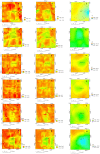Urban Greening Effect on Land Surface Temperature
- PMID: 35684787
- PMCID: PMC9185349
- DOI: 10.3390/s22114168
Urban Greening Effect on Land Surface Temperature
Abstract
Urbanization has accelerated the conversion of vegetated land to built-up regions. The purpose of this study was to evaluate the effects of urban park configuration on the Land Surface Temperature of the park and adjacent areas. In urban parks, the study analyzed the Normalized Difference Vegetation Index (NDVI), the Normalized Difference Built-up Index (NDBI), and the Land Surface Temperature (LST). The NDVI categorization process resulted in the development of a vegetation density distribution. The majority of Medan's urban areas were categorized as low density, as seen by their low NDVI values. The NDBI values were significantly higher in the majority of the area. This shows that the majority of places are experiencing a decline in vegetation cover. The density of vegetation varies according to the placement of park components such as trees, mixed plants, recreation, and sports areas. According to LST data, the temperature in the urban park was cooler than in the surrounding areas. Although the surrounding areas are densely populated, urban parks are dominated by trees. Additionally, there is a green space adjacent to the park, which is a green lane that runs alongside the main roadways.
Keywords: LST; NDVI; city park; remote sensing; urban greening.
Conflict of interest statement
The authors declare no conflict of interest.
Figures









Similar articles
-
Urban green space mediates spatiotemporal variation in land surface temperature: a case study of an urbanized city, Bangladesh.Environ Sci Pollut Res Int. 2022 May;29(24):36376-36391. doi: 10.1007/s11356-021-17480-9. Epub 2022 Jan 21. Environ Sci Pollut Res Int. 2022. PMID: 35060045
-
The effects of climate on land use/cover: a case study in Turkey by using remote sensing data.Environ Sci Pollut Res Int. 2023 Jan;30(3):5688-5699. doi: 10.1007/s11356-022-22566-z. Epub 2022 Aug 18. Environ Sci Pollut Res Int. 2023. PMID: 35978246
-
Quantitative assessment of land surface temperature and vegetation indices on a kilometer grid scale.Environ Sci Pollut Res Int. 2023 Oct;30(49):107236-107258. doi: 10.1007/s11356-023-27418-y. Epub 2023 May 9. Environ Sci Pollut Res Int. 2023. PMID: 37160519 Free PMC article.
-
Research on the spatiotemporal coupling relationships between land use/land cover compositions or patterns and the surface urban heat island effect.Environ Sci Pollut Res Int. 2022 Jun;29(26):39723-39742. doi: 10.1007/s11356-022-18838-3. Epub 2022 Feb 2. Environ Sci Pollut Res Int. 2022. PMID: 35107726
-
Spatiotemporal Variability of Urban Greenspace and Surface Temperature in Dhaka City: A Public Health Aspect.2023 Jul 1. In: Biloria N, Sebag G, Robertson H, editors. The Empathic City: An Urban Health and Wellbeing Perspective [Internet]. Cham (CH): Springer; 2023. Chapter 7. 2023 Jul 1. In: Biloria N, Sebag G, Robertson H, editors. The Empathic City: An Urban Health and Wellbeing Perspective [Internet]. Cham (CH): Springer; 2023. Chapter 7. PMID: 38091465 Free Books & Documents. Review.
Cited by
-
Monitoring and predicting development of built-up area in sub-urban areas: A case study of Sleman, Yogyakarta, Indonesia.Heliyon. 2024 Jul 14;10(14):e34466. doi: 10.1016/j.heliyon.2024.e34466. eCollection 2024 Jul 30. Heliyon. 2024. PMID: 39114072 Free PMC article.
-
Peculiar weather patterns effects on air pollution and COVID-19 spread in Tokyo metropolis.Environ Res. 2023 Jul 1;228:115907. doi: 10.1016/j.envres.2023.115907. Epub 2023 Apr 18. Environ Res. 2023. PMID: 37080275 Free PMC article.
References
-
- Wahlroos O., Valkama P., Mäkinen E., Ojala A., Vasander H., Väänänen V.-M., Halonen A., Lindén L., Nummi P., Ahponen H., et al. Urban wetland parks in Finland: Improving water quality and creating endangered habitats. Int. J. Biodivers. Sci. Ecosyst. Serv. Manag. 2015;11:46–60. doi: 10.1080/21513732.2015.1006681. - DOI
-
- Mauree D., Naboni E., Coccolo S., Perera A., Nik V.M., Scartezzini J.-L. A review of assessment methods for the urban environment and its energy sustainability to guarantee climate adaptation of future cities. Renew. Sustain. Energy Rev. 2019;112:733–746. doi: 10.1016/j.rser.2019.06.005. - DOI
-
- Kabisch N., Kraemer R., Brenck M.E., Haase D., Lausch A., Luttkus M.L., Mueller T., Remmler P., von Döhren P., Voigtländer J., et al. A methodological framework for the assessment of regulating and recreational ecosystem services in urban parks under heat and drought conditions. Ecosyst. People. 2021;17:464–475. doi: 10.1080/26395916.2021.1958062. - DOI
-
- Matzarakis A. Comments about Urban Bioclimate Aspects for Consideration in Urban Climate and Planning Issues in the Era of Climate Change. Atmosphere. 2021;12:546. doi: 10.3390/atmos12050546. - DOI
MeSH terms
Grants and funding
LinkOut - more resources
Full Text Sources

